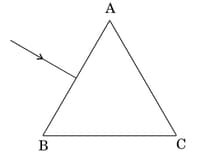Refraction Through a Prism
Important Questions on Refraction Through a Prism
The figure shows a ray of light falling normally on the face AB of an equilateral glass prism having a refractive index , placed in water of refractive index . Will this ray suffer total internal reflection on striking the face AC? Justify your answer.

Correct the following Sentence During dispersion through a prism, the blue colour is most deviated.
Why a right-angled prism is a better reflector than a plain silvered mirror?
Refractive indices of glass for the light of yellow, green and red colours are respectively. Rearrange these symbols in increasing order of values.
A parallel beam of light falls normally on the first face of a prism of small angle.The portion of the beam which is refracted at the second surface is deviated through an angle of and the portion which is reflected at the second surface and emerges again at the first surface makes an angle of With the direction of the incident beam. Calculate the angle of the prism and the refractive index of glass.
Show that for a prism whose refracting angle (A) is greater than twice the critical angle between the material of the prism and the outside medium, a ray incident at one face will not emerge from the other face, whatever may be the angle of incidence.
Show the nature of the curve for a prism. Analyse the curve to show that for any particular value of , the difference between the fixed values of and decrease with the decrease of and becomes zero for minimum.
What is the angle of minimum deviation? Obtain an expression for the refractive index of the material of a prism in terms of the refracting angle of the prism and the angle of minimum deviation.
What is the angle of deviation of a ray in connection with the refraction through a prism? Find an expression for it and explain, with a diagram, the variation of the angle of deviation with the variation of the angle of incidence.
Describe briefly the principle of operation of a totally reflecting prism.
Given that : for a crown glass prism, angle of minimum deviation and for a flint glass prism Where and refer to particular wavelength in blue, red and yellow bands. Compare the dispersive power of the two varieties of glass prism.
The refractive indices of crown glass for blue and red light are and respectively and those of the flint glass are and respectively. An isosceles prism of angle is made of crown glass. A beam of white light is incident at a small angle on this prism. The other flint glass isosceles prism is combined with the crown glass prism such that there is no deviation of the incident light.
Calculate the net dispersion of the combined system.
The refractive indices of crown glass for blue and red light are and Respectively and those of the flint glass are and Respectively. An isosceles prism of angle Is made of crown glass. A beam of white light is incident at a small angle on this prism. The other flint glass isosceles prism is combined with the crown glass prism such that there is no deviation of the incident light. Determine the angle of the flint glass prism.
Define Snell's Law. Using a neat labelled diagram derive an expression for the refractive index of the material of an equilateral prism.
Derive the equation for the angle of deviation produced by a prism and thus obtain the equation for the refractive index of material of the prism
Find the angle of minimum deviation for a prism of refracting angle and refractive index .
Draw a ray diagram for a monochromatic ray refracting from a glass prism. Write the expression for refractive index of glass in terms of prism angle and angle of minimum deviation.

